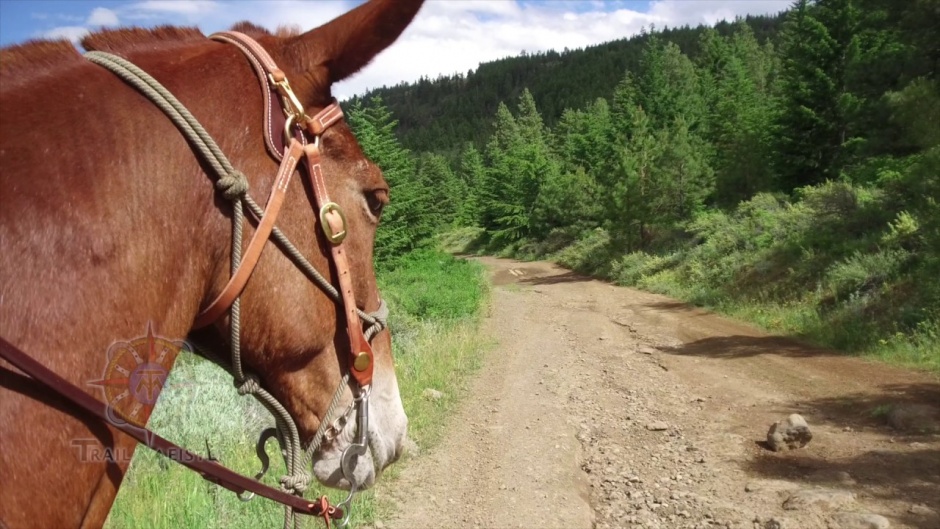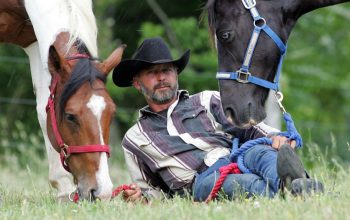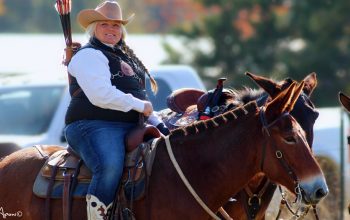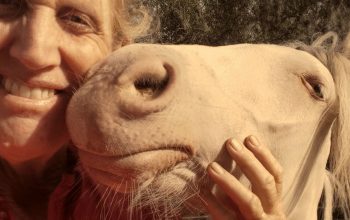Story and photo by Robert Eversole Trailmeister
 Greetings, I was originally going to write about low impact horse camping techniques for this month’s column. After all it’s fall and we’re starting to head out to the trails and camps in large numbers to enjoy the seasonal weather. However, instead of that I’d like to address a topic that is more important and one that may just save your life.
Greetings, I was originally going to write about low impact horse camping techniques for this month’s column. After all it’s fall and we’re starting to head out to the trails and camps in large numbers to enjoy the seasonal weather. However, instead of that I’d like to address a topic that is more important and one that may just save your life.
If you ride a horse or a mule you’ve experienced fear. Whether in an arena or on the trails the potential for a problem is real. Our job as riders is not to try to put aside our trepidation; in large part our fears are legitimate. However, If we can learn to understand those fears, and find ways to minimize the inherent danger of our equestrian activities, we’ll be much better riders, and also have a much better time on the trail. Anticipating the “what ifs” of an adventurous trail ride will help you to prepare for any eventualities that may occur during your outing. By mentally preparing yourself ahead of time you’ll find that the backcountry’s mountains and valleys are much less intimidating.
If we stop to think about it one of the biggest fears that we as riders experience is the fear of falling. Falling is the potential outcome of any problem we encounter. From a horse spooking at an imaginary monster, to our mule slipping on a bridge crossing, our root fear is that we’re going to hit the ground in a violent manner. If we can learn to control the fear of an unscheduled dismount perhaps we’ll be able to enjoy more of our ride. It may be counter-intuitive, but let’s spend a few minutes thinking about and visualizing how to perform an emergency dismount, and consider practicing this at home.
Once you’ve lost your seat so thoroughly that you’re going to come off (we’ve all felt that sensation) it’s time to take control of your fall. If you were to keep a death grip on your horse your fall could become an uncontrolled event that turns much more dangerous. With that in mind let’s go over the four main parts of an emergency dismount.
Kick your feet out of the stirrups and drop the reins, do not maintain a death grip on your mount. – The idea is to break all forms of attachment to the horse, you don’t want anything holding you to the horse; you want to be free and clear when you land. Don’t worry about the horse running loose; if you are in danger, then your safety comes first. Lean forward and use the horse’s neck to maintain some bit of control over your speed and direction as you dismount. As you’re coming off, use the horse’s neck to push against so that you land away from the horse and not underneath where you could be stepped on.
As your feet hit the ground, try to stay upright. and back up a few steps. If you’re already off balance, you may still fall (tuck and roll may help). Try to do it away from the horse. If you fall, tuck and roll away from the horse.
In an emergency dismount, try to land on your feet. This is much safer than landing on your head, your hip, or trying to break your fall with your arms. As in most things in life an emergency dismount works best if it’s a habit.
If you can perform these steps when you are in control, you are more likely to be able to do them when you lose your balance on the trail in the middle of the proverbial “train wreck”. Consider practicing an emergency dismount at home, in a safe setting with good footing for a practice fall at halt, to get the idea. Then try at walk. Once you feel comfortable doing an emergency dismount in a controlled situation, you may be much safer the next time you need it.
In addition to knowing emergency dismount techniques, how to come off your horse in a somewhat controlled manner here are a few more tips to help you battle the “fear factor”, whether you’re in the backcountry, the front country or anywhere in between.
Relax. Yes, this is much easier said than done. When you’re tense, your riding suffers and it feels even more frightening. If you can get your body to relax it will help you feel more relaxed emotionally as well.
Breathe. When you’re tense, you unconsciously hold your breath. To start breathing regularly try talking or singing; when I get nervous and tense you’ll often hear me singing. Badly. You may not win a Tony but you will feel much better.
Balance. When you’re tense, you tend to lean forward into a fetal position. Fight this by sitting up straight and deep in the saddle, putting your shoulders back (I tell my students to sit tall like a soldier). and feel how much easier it is to breathe, and sing, and relax.
And finally find something to focus on that’s positive. Think about what a great day it is and how much fun it is to ride with your favorite trail buddy. Fear can ruin a great ride but you can overcome your concerns by centering on all the wonderful circumstances that have led to you being in the saddle and on the trail.
 As always, for more information on this and other topics, as well as the nation’s largest source of horse trail and horse camping information in the U.S. please visit the all new
As always, for more information on this and other topics, as well as the nation’s largest source of horse trail and horse camping information in the U.S. please visit the all new
www.TrailMeister.com.




